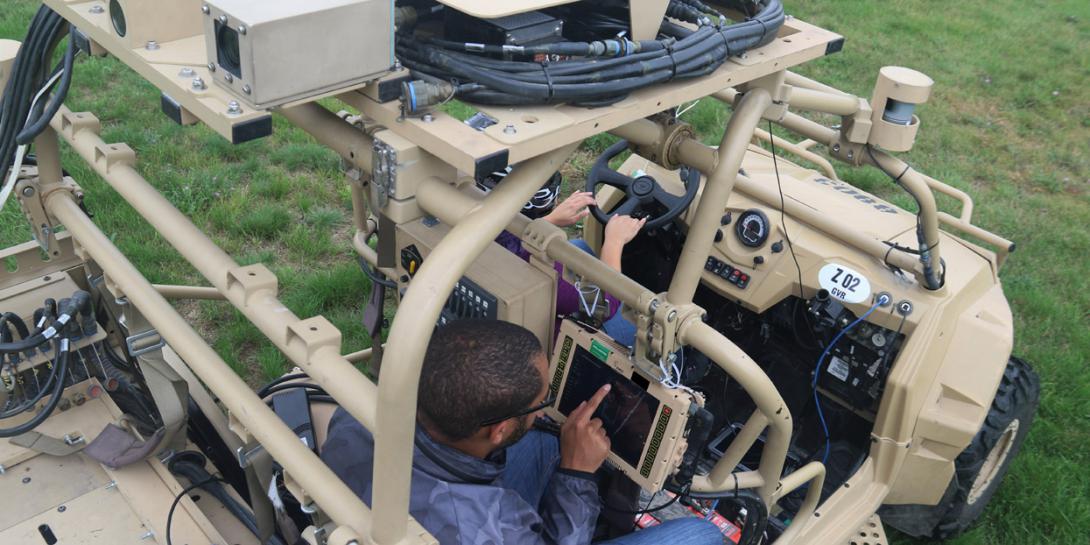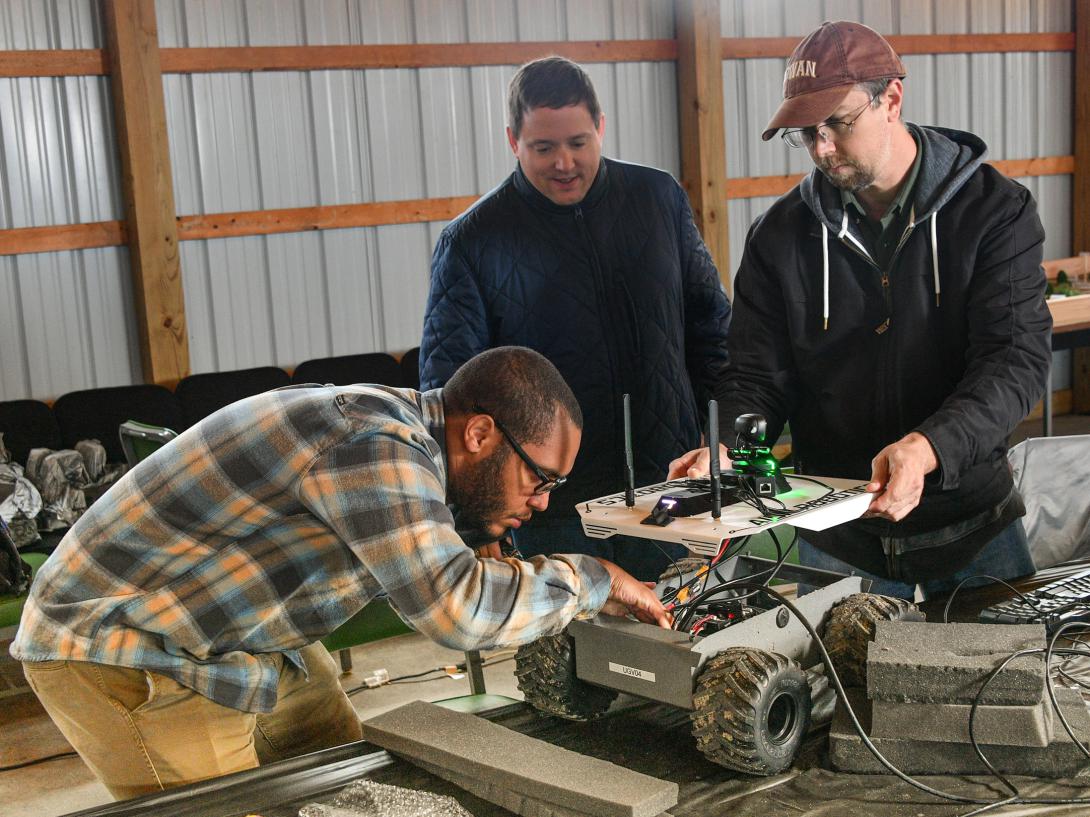Future Robots Will Be Easy on Soldiers, Tough on Foes
The U.S. Army envisions future robotic vehicles that are easy for soldiers to operate while proving difficult for enemy forces to detect, jam or hack. Researchers at one of the service’s premier research and development centers are racing to build the sensors, communications links and software needed to make that vision a reality.
The Remote Combat Vehicles, known as RCVs, will likely come in various sizes and with different degrees of autonomy. They may be operated by the crew inside the next generation of combat vehicles, which will be optionally manned, meaning they may or may not have a crew, depending on the situation. Though loaded with sensors and radios, the robots are expected to be hardened against electronic warfare and cyber attacks. A manned, next-generation combat vehicle could be paired with up to four RCVs.
The RCVs may be armed. They also could be sent ahead of the manned vehicles to scout out the area, navigate through the most dangerous sectors of the battlefield and engage the enemy. The package of sensors could include infrared or radio frequency sensors, as well as video cameras offering a 360-degree view.
Officials within the Army’s Command, Control, Communications, Computers, Cyber, Intelligence, Surveillance and Reconnaissance (C5ISR) Center say the RCVs will require a robust package of communications technology, mission command software and sensors. “They’re going to require some pretty hefty communications links. Those communications links are going to be really critical to both control those robotic platforms as well as get the video and sensor feeds back from those unmanned platforms to the optionally manned vehicles,” says Daniel Duvak, chief for the C5ISR Center’s Radio Frequency Communications Division.
Under the Protected Communications for Manned-Unmanned Teaming (MUM-T) Project, Duvak and his team have signed cooperative research and development agreements with two companies, Silvus Technologies and Persistent Systems. The C5ISR Center recently has been using the agreements in novel ways.
Silvus specializes in multiple input and multiple output (MIMO) devices, which essentially boost the capacity of a radio link using more than one antenna. The company is providing its StreamCaster radio. On its website, Silvus describes StreamCaster as the world’s first tactical MIMO radio.
The company is enhancing its product for the RCV effort. “They’re adding resiliency, which is the anti-jam, low-probability of detection and cyber hardening, as well as performance improvement—low latency and the high-throughput communication,” Duvak reports.
Meanwhile, Persistent Systems is supplying researchers with its MPU5 radio, which the company describes as the world’s first smart radio that is “built to create powerful, secure networks anywhere.” Like Silvus, Persistent Systems also is hardening its radio. “What they’re doing is very similar, adding anti-jam, hard-to-detect features, cyber hardening, really making it difficult for the adversary to either detect or jam those radio signals,” Duvak says.
Both companies are working under 14-month contracts, which began just a few months ago—July for Silvus and October for Persistent Systems. Both radios were capable of throughput in the 10 megabits range even before enhancement, Duvak says. “We can do four, five, six, maybe even 10 video feeds simultaneously across these radios. This isn’t just making voice calls. It’s collecting all that sensor data, all that video feed data, from the forward unmanned vehicle to the manned platform, a kilometer or several kilometers back. They’re really high bandwidth,” he adds. “You could have these video feeds coming from two different unmanned platforms. That’s how you could start to need those higher numbers of video feeds.”
Initially, the data provided by the RCVs would be sent back to the manned vehicles and could then be passed on, such as to a command center. “That manned vehicle is going to be part of the larger network. They’re going to have the option to send that data anywhere else within that unit,” Duvak offers.
For operational security reasons, researchers cannot specify what steps the companies are taking to improve their products, but generally speaking, manipulating the direction of transmissions is one way to protect a radio from detection or jamming. MIMO antennas can be used to direct radio transmissions toward friendly forces and away from enemy troops, for example. They also can nullify interference. “That can be interference generated by the vehicle you’re on, like electromagnetic interference. That could be the adversary. So, there’s a number of different things you can do with those MIMO antennas and with your antenna patterns that can be advantageous,” Duvak says.
The Army is purchasing both the MPU5 and the StreamCaster, and units already using them could benefit from the C5ISR Center’s upgrades. “The application of what we’re doing here is going to be further reaching than just the MUM-T product,” says Frank Bohn, chief for the Radio Frequency Communications Division’s Electronic Protection and Interference Mitigation Branch. “This could be integrated for regular vehicle-to-vehicle communications or from manned portable, handheld radios. There are a lot more applications than just the MUM-T portion of this.”
At the same time researchers make the RCVs difficult for enemy forces to detect or attack, they also want to make them easy for U.S. soldiers to operate and supervise. “If you have a soldier constantly having to look at or operate a system all the time, you’re taking them out of the fight,” notes Osie David, project lead for the C5ISR Center’s C4ISR Modular Autonomy Project, which is run out of the Command, Power and Integration Directorate. “It’s like having a 2-year-old running around the house. It’s hard to do other tasks if you have to constantly supervise that 2-year-old, which a lot of these robots are like.”
They will ease the burden on soldiers, in part, by integrating commercial systems with government-owned software, including the Mounted Tactical Assault Kit, or MTAK, a mobile app that provides geospatial and situational awareness information and will be used for robotic system planning and execution. The C4ISR Modular Autonomy Project personnel are working with two companies, Neya Systems LLC and Soar Technology Inc., commonly known as SoarTech.
Neya specializes in off-road perception and autonomy, according to its website. “That piece is mainly focused on the tasking of robotic systems, coming up with schema to allow a user to provide a series of tasks to robotic assets, and retasking as well,” says Daniel Lenhardt, a computer engineer with the C4ISR Modular Autonomy Project.
SoarTech’s website says the company builds intelligent systems that emulate human decision-making. The SoarTech software will provide soldiers with alerts when needed, such as when a robotic vehicle wanders into forbidden territory. “If a robotic asset crosses a phase line or detects an enemy asset, it will try to report that information back up so it’s received and utilized by the commanders,” Lenhardt says.
David’s team has worked with both companies for roughly two years through small business innovation research grants. Soldiers already have evaluated SoarTech’s technology and provided positive feedback, he says. “That really is meant to help relieve a lot of the burden on the soldier such that you don’t have to man operate an [unmanned vehicle] by constantly looking at it and checking its status. You’re really relieving the soldiers’ burden … so the soldiers are then free to perform all their tasks.”
David also touts the importance of planning software, which he says is “one of the most overlooked things.” For instance, if warfighters want a robot to search a specific area, that seemingly simple task involves a lot of steps and substeps. The planning software provided by Neya will help plot those various steps so that soldiers don’t have to. “Instead, soldiers can just review a plan the system has come up with and make changes as necessary.”
Integrating commercial and government equipment also will allow the Army to minimize the amount of unique equipment on the battlefield. “A lot of the capabilities for robotics … bring their own command and control system, their own joystick capability. What we’re looking to do is combine technologies from our contractors, as well as some of our own government-developed work. It is integrated into an actual Army system so you don’t have to have every technology on the battlefield have its own system in order to report in,” David says.
That will allow soldiers to use existing mission command systems and a common operating picture for mission planning, monitoring and execution. “It’s something they’re already familiar with. It exists today, and we’re bringing the robotic capabilities into that without having to have soldiers learn a brand new system or have to incorporate more hardware or different software,” he adds.
Lenhardt echoes that statement. “Currently a lot of different companies have their own systems, their own architectures, their own schemas, so we’re trying to provide some guidance in that realm. It’s still ongoing.”
The mission planning team is about halfway through a two-year effort. At the end of the program, they expect to have a mission command system capable of demonstration in a relevant environment, a rating of six on the technology readiness level scale.
The system likely will be demonstrated at either Fort Dix, New Jersey, or Camp Grayling, Michigan. The event is expected to include integrating the various programs into the MTAK system, linking to a robotic platform, building the common operating picture, sharing data, creating and implementing a plan, and monitoring the robot’s activities. Assuming all goes well, the system will be ready to transition to the mission command program office.
Future iterations of the mission command system could include voice commands, making things that much easier on warfighters.
The most important goal, says Mbakhane “NJ” Ndiaye, project lead for the Protected Communications for MUM-T Project on Duvak’s team, is making it easier for war-fighters to return home. “If you give our commanders an option to send a remote robot in the kill zone, I think they will not hesitate. That’s what we are allowing our commanders to do. The bottom line is we want to save soldiers’ lives,” he concludes.







Comments